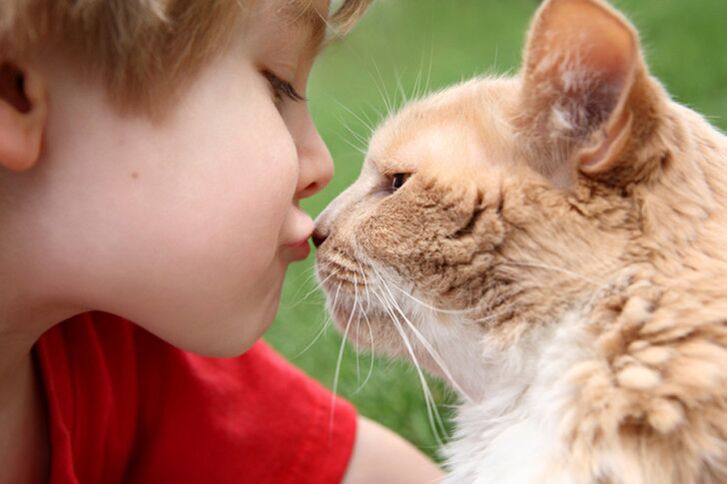
Why is helminthiasis dangerous?
The majority of helminthiasis of the most common species in children parasitize in the intestines. They live and feed in it, as a result of which they multiply and emit toxins. Parasitic worms also mechanically affect the intestinal wall. The consequences of the active life of worms in the child's body:
- Avitaminosis and weight loss. These problems arise due to the lack of nutrients and vitamins. As a result, children lag behind in development. Pathological processes can also start in other organs.
- Intestinal inflammation, colitis, dysbacteriosis, bleeding. All these unpleasant and serious complications are caused by mechanical damage to the body caused by children's worms.
- Development of inflammatory processes in the appendix, liver, gall bladder. These are organs adjacent to the intestines into which parasites can move.
- Ileus. It can be partial or complete, and sometimes there is a risk of rupture of the intestinal wall.
- body poisoning. When worms live and die in humans, they release aggressive toxins.
- Allergy. The waste products of parasites are considered strong allergens.
- Violation of liver function. For this reason, the child must follow a diet for many years and in addition consume enzymes.
- Psychosis. Helminths usually have a negative effect on the patient's nervous system.
Types of worms that affect the child's body
Many types of parasites can appear in the child's body. They are of different sizes, small and large, and manifest in different ways and have different incubation periods, which range from 1 to 1. 5 months. In order to prescribe effective drugs that help cure helminthiasis, it is necessary to correctly determine their type. The most common types in children are:
- Tape. This type of worms includes cestodes, dwarf tapeworms, tapeworms and echinococcus.
- Ring. Among them are the annelids.
- Wheel. Their representatives are trichinella, pinworms, whipworms, nematodes, roundworms.
- He's prickly. They are represented by scrapers.
- Apartment. Among them are trematodes and flukes.
Causes and methods of infection
You can get infected with helminthiasis not only in an exotic country or by trying unusual food on the menu. Playing in the sandbox and unwashed hands are the easiest ways for worms to enter a child's body. Young children tend to touch and study everything without thinking about the cleanliness of the object being examined. After that, they can lick their fingers without washing them first. Worms remain viable for a very long time (weeks to months), remaining on the surface of various objects.
In addition to dirty hands, the main sources of infection are:
- dirty toys and surfaces;
- dresses;
- shoes;
- barriers at the entrance;
- handles;
- raw water;
- dirty vegetables and fruits;
- soil, earth, sand;
- contact with a sick child;
- insufficiently cooked meat;
- poorly thermally processed fish or other seafood.
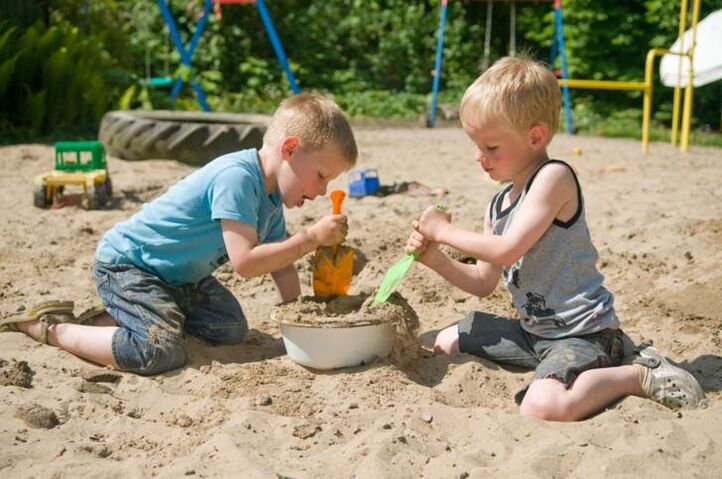
Symptoms of the presence of parasites in children
In general, in children younger than 1 year, the manifestation of the presence of parasites in the body can be observed in individual cases. The first symptoms that point to helminth infection appear at an older age (about 2-3 years old) in children attending kindergarten or other developing institutions.
Helminthiases in children show a huge variety, and each type has its own characteristics. However, there are several symptoms that are common to any type of worm:
- irritability and bad mood for no apparent reason;
- restless sleep;
- allergy;
- itching in the anus;
- increased secretion of saliva;
- disturbed digestion accompanied by diarrhea, constipation, nausea and bloating;
- loss of appetite;
- weight loss with good nutrition;
- pallor of the skin.
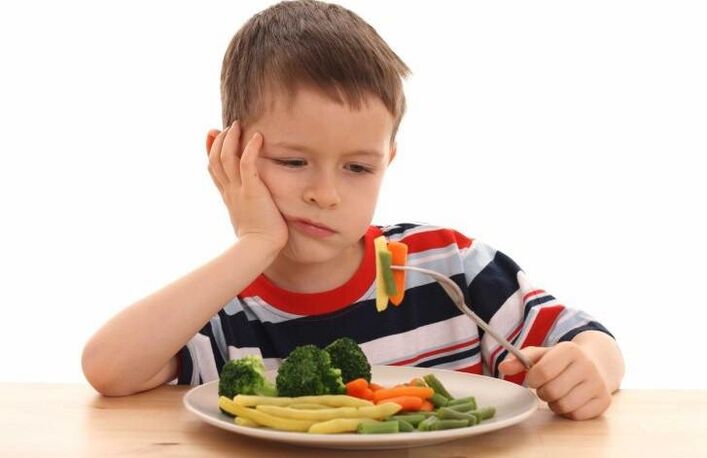
In adult children, these symptoms may include:
- headache;
- discomfort in the stomach;
- dizziness;
- increased fatigue;
- poor concentration.
Enterobiasis (pinworms)
The disease when parasites such as roundworms enter the child's body is called enterobiasis. This type of helminth is one of the most common in children of preschool age - between 2 and 5 years. They are medium in size, ranging from 5 to 13 mm, and cause minimal damage compared to other types of parasites.
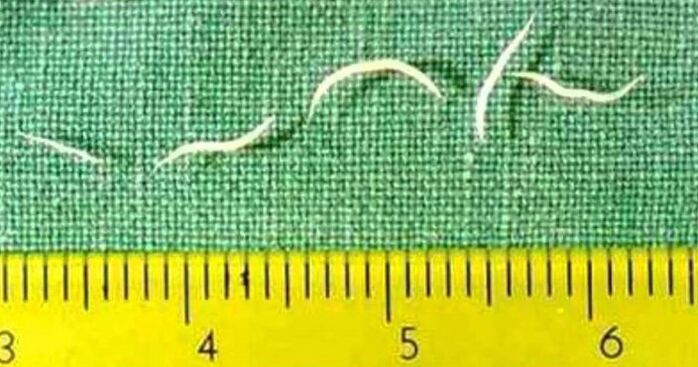
Their presence causes the following symptoms to appear:
- Violent itching in the anus. Its intensity can be so strong that the child will not sleep well, scratches the anus, causes irritation and inflammation.
- Urinary incontinence during night sleep. It is seen in girls. This happens when worms from the anus enter the urethra. As a result, the baby begins to develop urethritis, vaginitis or cystitis.
Pinworms are easy to get rid of and are not as dangerous as other types of worms. It is important to consult a doctor in time when the first signs appear and undergo the necessary tests. If pinworms are found in a child, the parents also need treatment. All clothes, towels and other rags should be washed and ironed, and the room should be thoroughly washed, as the eggs of these worms can be found on all surfaces of the infected person's house.
Ascariasis (roundworm)
The second most common in children are roundworms, up to 40 cm long, living in the small intestine - roundworms. In addition to the general symptoms of helminthiasis, in the case of ascaris, the infected person causes an unreasonable cough in the initial stages in the absence of inflammatory processes in the respiratory tract. Its appearance is due to the fact that the larvae of this type of parasite enter the lungs and upper respiratory tract, and then return to the stomach through coughing.
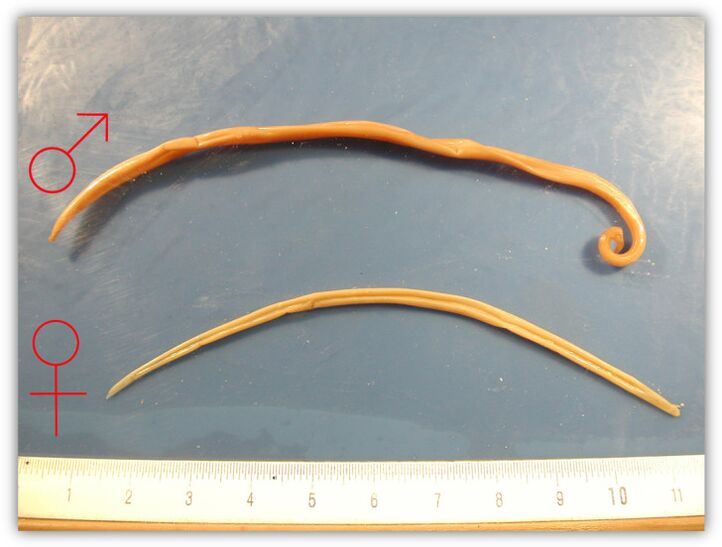
Other typical features:
- headache and dizziness;
- allergy;
- enlarged lymph nodes;
- elevated temperature;
- intestinal disorders.
At the same time, buttock itching associated with roundworms is absent. Not only the intestines, but also any other organ or system of the body can become a habitat.
Trichuriasis (moustache head)
These children's parasites are very thin-bodied worms that reach 5 cm in length. A female whipworm can lay up to 2, 000 eggs at a time. In general, such helminths occur more often in adolescence and appear much less often in young children.
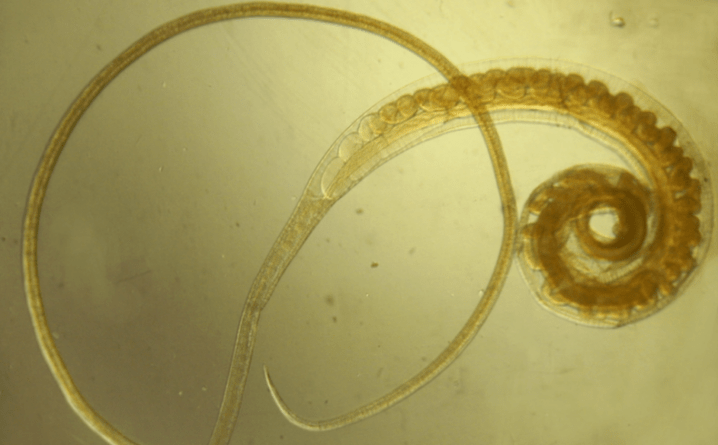
A distinctive feature of trichuriasis is the almost complete absence of signs of helminthic invasion. Possible symptoms include:
- disturbances in the work of the nervous system (irritability, headache);
- digestive problems accompanied by diarrhea, nausea or vomiting;
- rise in body temperature.
Signs of other parasites
Among other types of worms in children, the following can be distinguished:
- Hymenolepiasis or pygmy rat tapeworm. There are no specific symptoms. Its presence can be recognized by nausea, loss of appetite, heartburn, diarrhea and constipation, headache, abdominal pain, increased salivation, dizziness, fatigue, skin rashes, allergic rhinitis and bronchospasm.
- Opisthorchiasis or feline Siberian flu. In children, these worms cause subfebrile temperature, skin rashes, swollen lymph nodes, joint and right hypochondrium pain, pancreatitis, gastritis and other signs of malfunction of the digestive system, constant catarrhal syndrome and much more.
- Toxocariasis. It spreads through animals. The main symptoms are a suffocating allergic cough and skin rashes characterized by severe itching.
- Wide band. The source of infection is not fried or undercooked fish. Symptoms include abdominal pain, allergic reaction, B12 deficiency anemia and other common signs of bowel disease.
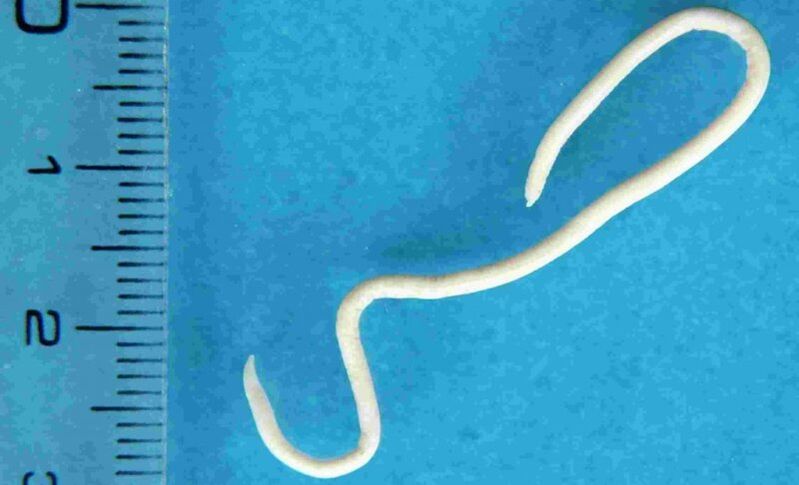
How to check if your child has worms?
In most cases, it is difficult for parents to associate specific symptoms with helminthiasis or to understand why the child has sudden vomiting or other symptoms for no apparent reason. In case of the slightest suspicion of the appearance of worms, it is necessary to consult a specialist and perform tests that facilitate the verification of the assumption of helminthic invasion. It does not require a lot of time and effort, but the cause of the baby's illness will be exactly clear, and treatment can be carried out in time.
Self-diagnosis
Self-diagnosis is the careful monitoring of changes in the child's behavior, development, habits, routine and normal state - both physical and emotional-psychological.
Includes:
- periodic examination of feces for the presence of worms;
- checking the frequency of visits to the toilet;
- examining the skin for rashes, redness, or irritation;
- controlling the amount of food consumed.
Testing
A medical diagnosis is required to confirm the diagnosis if worms have been observed visually or only if worm infestation is suspected. To find out the cause of your symptoms, you will need to undergo a series of tests, which include:
- Stool analysis. Eggs or parts of mature worms can be found in it. The efficiency of the method is maximum in the period when there are already mature individuals in the intestine, e. g. about 3 weeks to a month after infection. Feces should be collected in the morning and sent to the laboratory.
- Smear or scrape on the anus. To do this, use a dry cotton swab dipped in glycerin or adhesive tape. The analysis allows the identification of worm larvae deposited on the skin areas of the anus.
- General blood test. Patients with helminthiasis in the blood may have an increase in the number of immune cells, high erythrocyte sedimentation rates, and decreased hemoglobin levels.
- ELISA blood test. It allows the detection of parasites at an early stage using staining enzymes that attract worms, viruses and other foreign bodies.
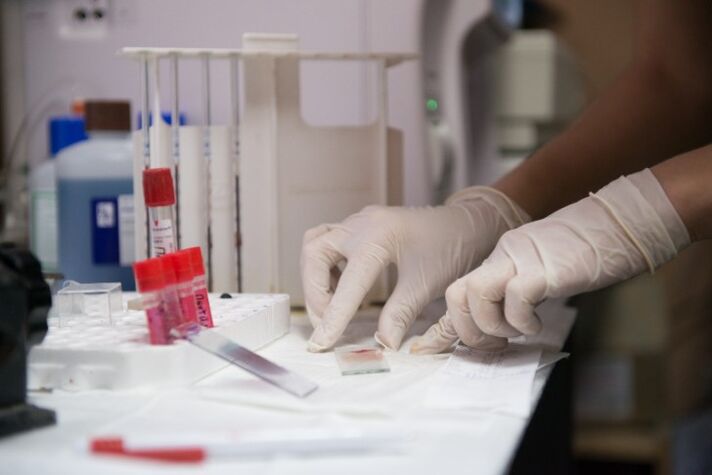
Additional tests for parasites in children that can be done in an outpatient setting include:
- analysis of the presence of IgG antibodies;
- ultrasound procedure;
- X-ray.
Features of drug treatment
The appointment of drugs to combat parasites in children should be done by a doctor after passing all the necessary tests and establishing the exact diagnosis and type of worms. Among the most common drugs against helminthic invasion, it should be noted:
- An anthelmintic drug that acts on nematodes. Acceptance is allowed from the age of 6 months. Effective against all types of roundworms, but useless against flatworms.
- An anthelmintic drug belonging to the benzimidazole group. It was appointed until the age of 2-3 years. The dose is determined as 10 mg/kilogram of body weight.
- Antiprotozoal and antimicrobial drug from the group of nitroimidazoles. It is suitable for all ages, according to which the daily dose is determined.
- An anthelmintic drug belonging to the benzimidazole group. For children from 2 years old against roundworms.
What folk remedies can help?
In addition to medicines, worms can also be treated with folk remedies.
The most popular products that can effectively treat worms in children:
- Garlic. It successfully kills roundworms, tapeworms, roundworms and copes with many other types of parasites. Suitable for children from 5 years of age with a healthy stomach. 1 clove should be administered once a day before a meal. It can be taken with water or milk. Garlic is also an excellent antiviral agent.
- Pumpkin seeds. It should be eaten on an empty stomach and raw. In general, children like this treatment. Otherwise, they can be crushed and mixed with honey if the child is not allergic to honey.
- sage. Allowed for children from 12 years of age. To simplify the reception, it should be mixed with a piece of bread and salt.
- Fresh carrot juice. Half a cup on an empty stomach once a day for 7-10 days is enough. You can also chew raw carrots.
- Beet juice. It is administered on an empty stomach. It is advisable to alternate with carrots so as not to provoke stool violations.
- Walnut. A few pieces a day will be enough for a child.
- A pineapple. Fresh, non-canned fruit is a tasty and effective remedy.
- citrus fruits. You can add sour-tasting berries and fruits to their "company".
Prevention

Regardless of the type of worms, prevention depends on following the basic rules of personal hygiene:
- Washed food. All vegetables, fruits and berries must be washed thoroughly before eating. As an additional measure, the products can be poured with boiling water.
- Clean hands. They must be washed before eating, after walking, visiting the hospital and being in public places, after going to the toilet and playing with animals, even pets.
- Deworming of pets. It must be done at least twice a year.
- Boiled or filtered water for drinking. It is forbidden to drink water from open reservoirs. Bathing in them should also be avoided to avoid splashing water in the mouth. Salt lakes and seas are exceptions.
- Regular prevention using folk remedies.
- Caring for old and new toys. Soft toys should be washed regularly, plastics and plastics should be washed with boiled water. New ones must be washed with boiling water before giving them to a child.
- No insects! Flies, mosquitoes and cockroaches carry worm eggs on their paws. It is important to prevent them from entering the house. To do this, you can use incense, adhesive tape and special crayons.
- Exclusion of fish and meat dishes that require low roasting of animal products from the child's diet.
- Stool analysis once a year. This procedure helps to detect worms in their early stages.
















































